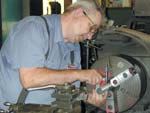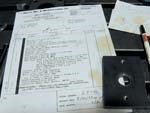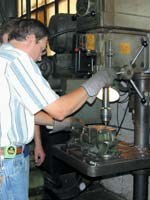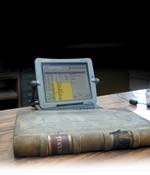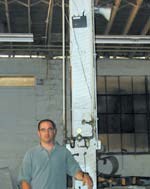The Data Exchange
Many machine shops contemplate updating their software but are reluctant to do so based on fears of lost or unusable data. This company made the switch unscathed and offers tips on what software features can help fulfill a shop's needs.
Share





When it began investigating shop control software, Duplex Mill & Manufacturing Co. (Springfield, Ohio) faced three fundamental issues regarding its data: transferability, accessibility and usability. If the company purchased a new system, would it be able to easily transfer data from its off-the-shelf accounting program, and would the new software make its data more accessible in the future? Would the switch to a new software package increase its efficiency by arranging data into a more usable format?
Many small shops are familiar with the situation that drove Duplex Mill to investigate shop control technology, because they are similarly operating under an off-the-shelf accounting software environment. Duplex Mill found that while its universal accounting software would suffice for a time, the program was beginning to limit the company's ability to change and grow. Based on lessons learned from past experience with such software, Eric Wise Jr., information technology director at Duplex Mill, was moved to compile a list of necessary features that any software package the company would purchase must have. When the company eventually narrowed its search and decided to purchase a shop control system, it found that all three of its questions about data transfer, access and use were answered with a resounding "yes."
The company also discovered that while researching shop software options can be a formidable task, the upgrade itself does not have to be a frightening experience and can produce real benefits.
Duplex Mill's quest to integrate shop control software into its operations poses a striking contrast to what can be found in its machine shop. This shop does not use CNC or NC technology. In fact, the machine shop at Duplex Mill could be a metalworking museum of sorts. The oldest machine in the shop is circa 1860. Six manual lathes grace the shop in all, bearing the names of bygone manufacturers such as Logan, Warner & Swasey and Lodge & Shipley. There is a radial arm drill from Cincinnati, three manual milling machines and grinders used to hand-sharpen tools.
While this machine shop is characterized by metalworking equipment on the low end of the technology spectrum, it is not marked by antiquated business operations. Rather, the company has invested its resources into the appropriate technology it needs to effectively run the business. Other areas of shop operation, such as ordering, shipping and billing, have commanded more technological advancement in order for the company to stay viable. The veteran machinists and other employees have significant computer skills, and they commonly use traveling notebook computers on the shop floor. The technology available to the company will only improve with the assistance of its shop control system, which will facilitate the use of hand-held computer devices and Web-based order communication with customers.
Archive Evolution
Duplex Mill finds that its investment in shop control technology has increased efficiency by allowing it to more effectively use information on multiple levels. Mr. Wise originally invested in this technology because he foresaw a potential for it to improve shop activity beyond the realm of the old accounting system's capabilities. However, this call for new technology has not been present in the company's machine shop. Duplex Mill actually has no need for CNC capability because employees only run about 20 parts per day. Machined components follow hardened patterns used over and over, and the company's three machinists—who have more than 75 years of experience among them—can easily do the one-off jobs on manual machines armed with their expertise.
The parts are components of mixers and blenders primarily used in agricultural and industrial applications for continuous or batch operations. An assembly of these machined parts can be likened to the beaters used in a kitchen mixer, but there are many advanced functions performed by Duplex Mill's "beaters." The products, sold under the Kelly Duplex name, can be used to handle multiple materials such as plastic, cement, powder and animal feed grains, and the company designs these machines to crush, convey, elevate, reduce, separate and more. The bulk of Duplex Mill's 18,000-square-foot facility is dedicated to fabrication and the assembly of the sheet metal that forms the funnel-shaped body of the machines. This tried-and-true design has realized little change over the past 100 years, but the machines' uses have become more complex; where once they were primarily used by large farmers to mix cattle or horse feed, now they are also used by a toy company to mix plastic for injection molding.
Duplex Mill views shop control functionality as a valuable tool, but, obviously, this shop control technology was not available when the company first began finishing castings for the now-defunct Western Foundry Co. in 1884. Duplex Mill began accounting for shop activity just like any other business in the late 1800s: with handwritten ledgers. The company can trace the evolution of its accounts by delving into the volumes upon volumes that recorded the bottom line for each fiscal year until the 1980s. However, when the company first integrated computer technology into its operations, Mr. Wise says it wasn't such a big step for functionality. The company began using a rudimentary accounting program written in the BASIC computer language by an independent software programmer. This system did accelerate the process of inputting information and reduce the possibility of human error, but the shop did not benefit from any added capacity because it was not able to manipulate and use the information in new ways. In effect the accountant was now typing the information into a computer instead of handwriting it into a book.
Duplex Mill maintained this account tracking program until it purchased Peachtree, a widely familiar off-the-shelf accounting system. The biggest advantage this system provided to the company was that it eliminated the risk of putting all the company's information into an unconventional system—almost every accountant knows how to use it. In addition, the system did save labor time by providing some new functions; for instance, it updated all ledgers automatically when someone entered a new item into the quoting or invoicing columns. As time went on, however, Mr. Wise discovered there were still more savings to be realized through more efficient management of time and labor.
Working within the confines of Peachtree, Mr. Wise began his search for new software in no hurry, because this time he wanted to get all the capability Duplex Mill required, and nothing less. He created a "must have" list of features. (See Figure 1 on next page.) He also composed a list of functions he would like to see, such as scheduling capability and Internet functionality.
Duplex Mill decided to purchase the E2 Shop System from Shoptech Industrial Software Corp. (Rocky Hill, Connecticut) and prepared for total implementation of the system on the first day of the company's new fiscal year, June 1, 2001. This event ushered in a 3-week adjustment period to the new system as well as a fine-tuning of both the software and the company's procedures. Mr. Wise expected that his extensive research coupled with some internal adjustments would assure that Duplex Mill's information was readily accessible.
An Open Architecture
When Mr. Wise initially looked at possible software packages to replace Peachtree, his primary goal was to find software that used an "open" database in order to make the company's information more accessible. "That requirement almost immediately eliminates 50 percent of the programs out there. For a lot of people that won't matter," he says, "but I am looking at it from a security standpoint. I want to make sure that almost no matter what, we can get our information."
Use of an open database, such as Microsoft Access that can be used with E2, also increases forward capability. In other words, storing data in an open database allows Duplex Mill to easily transfer its information to another program if for some reason its current system is no longer available. An open database is the opposite of a proprietary database, which may hinder the transfer of a company's data into a new system. In the event that forwarding the information is not a possibility, a company would have to hire a specialized programmer to decode the program and retrieve its data.
Shoptech was able to capture all the important information from Duplex Mill's database, so Duplex Mill was able to forward its customer, vendor and inventory information into the E2 system from Peachtree. Duplex Mill sent a CD containing its database to Shoptech, and the software vendor transferred the information into Duplex Mill's shop control system in one day. Paul Ventura, senior vice president of sales and marketing at Shoptech's Cincinnati, Ohio, office, says many companies may shy away from installing new software because they anticipate a long process re-keying in all the data, but software vendors do many data transfers like this one every day.
New Capabilities
When machinists at Duplex Mill first heard that an "open" system would increase capacity on the shop floor, they may have gotten the impression that the lathes would be available for more use. Now, the company's employees are very aware of this new open architecture shop control system, because it makes their jobs easier. The additional functionality that Duplex Mill's operations have realized since implementation of the shop control system has allowed the company to increase the efficiency of labor, resources, communication and information. (See Figure 2.)
Labor. Due to the efficiency of the software, the company now realizes 50 percent more productivity per employee because skilled machinists have been freed from having to perform data-entry tasks. For example, machinists no longer have to re-key customer information into a computer because the software includes this information automatically in each order entry. The machinists can then spend that time in the machine shop.
Resources. Material costs have been reduced because the shop control system has increased the information readily available to employees involved in purchasing. Since vendor information is stored in the E2 system, Eric Brickson, operations manager, can view past purchase price data as he calls in an order for steel. Now, he can tell the vendor what Duplex Mill is willing to pay by quoting the lowest purchase price, instead of asking the vendor what the steel will cost. "With the pricing information in front of you, you pay less," Mr. Brickson says. It also allows him to "push" the vendors by comparing prices offered by other vendors.
Communication. A machinist may decide to start a job and realize the material has not arrived. Instead of involving Mr. Brickson to track down the stock, the employee can log onto one of the traveling notebook computers located in the shop and look up the order number on the system. If the employee sees that the material vendor has already been called, a note attached to the file will indicate when the steel is expected to arrive. If not, the machinist can call the vendor. Not only does the shop control system reduce labor time spent on these common tasks, it also reduces duplication. No longer will several Duplex Mill employees call the same vendor in one day looking for material.
Attaching documents such as a part drawing, a metal certification or a note to employees concerning an account to data files also improves communication among employees. Mr. Wise says a machinist may be boring a hole and say, "Next time we need to move this hole over here." The machinist can attach a note to the file, and the next time a customer orders the part, whoever does the job can make the appropriate change.
Information. Time the company devoted to implementation also led to benefits. For instance, the inventory information took about two weeks to be organized within the system, Mr. Wise says, but an added benefit was that the company could now distinguish production-related inventory, such as material, from non-production-related inventory, such as the banding used in shipping. Additionally, it took the first 20 days to get enough information on the basic machines into the system to develop a plan for a machinist to build a particular product. This included information that would be stored in E2 but that was not captured by Peachtree. Getting this data into the system was important because most of Duplex Mill's products have components that can be customized to each order, such as capacity (size).
More Payoff To Come
While Duplex Mill probably will not invest in CNC equipment any time soon, it knows there is still more information technology that can further free employee time.
1) Pocket PCs. Imagine this scenario: A veteran machinist finishes using a manual machine to bore a hole in a piece of metal then reaches into his pocket and pulls out a hand-held PC to log off the job and to find out what needs to be done next. The "Pocket View" from Shoptech will save time because it makes all the information shop personnel need easier to access. There will be no need for them to walk around the shop to look at the job board, to scan bar codes or to clock in and out.
2) WebView. The company's next step will be to make order information accessible to customers via the Internet. Clients will be able to log onto the company's Web site, enter a password, and see if an order is still on time for delivery or find out the UPS shipping number. Through Shoptech's WebView and CRM (Customer Relationship Management) technology, the customer will be able to access quoting and invoicing information as well.
All of the improvements the company has realized, along with those yet to be implemented, help the shop become more profitable, says Mr. Wise. It was absolutely imperative for Duplex Mill to make changes in its business in order to use its resources more efficiently, and so far that quest has been a success. The company has realized more capabilities with its shop control system than it ever could have with its accounting program, and additional benefits include reduced labor and material costs. Mr. Wise put much time and effort into finding the right system to fit Duplex Mill's needs and making sure that the company's information would be readily accessible to those who come after him. After all the improvements to the company's procedures are complete, perhaps the payoff of this labor will keep Duplex Mill viable for another century or so.
Related Content
Generating a Digital Twin in the CNC
New control technology captures critical data about a machining process and uses it to create a 3D graphical representation of the finished workpiece. This new type of digital twin helps relate machining results to machine performance, leading to better decisions on the shop floor.
Read More5 Tips for Running a Profitable Aerospace Shop
Aerospace machining is a demanding and competitive sector of manufacturing, but this shop demonstrates five ways to find aerospace success.
Read MoreHow to Mitigate Chatter to Boost Machining Rates
There are usually better solutions to chatter than just reducing the feed rate. Through vibration analysis, the chatter problem can be solved, enabling much higher metal removal rates, better quality and longer tool life.
Read MoreAutomated CAM Programming – Is Your Software Really Delivering?
A look at the latest automation tools in Autodesk Fusion 360 software and how forward-thinking machine shops and manufacturing departments are using them to slash delivery times and win more business.
Read MoreRead Next
Setting Up the Building Blocks for a Digital Factory
Woodward Inc. spent over a year developing an API to connect machines to its digital factory. Caron Engineering’s MiConnect has cut most of this process while also granting the shop greater access to machine information.
Read MoreBuilding Out a Foundation for Student Machinists
Autodesk and Haas have teamed up to produce an introductory course for students that covers the basics of CAD, CAM and CNC while providing them with a portfolio part.
Read MoreRegistration Now Open for the Precision Machining Technology Show (PMTS) 2025
The precision machining industry’s premier event returns to Cleveland, OH, April 1-3.
Read More











